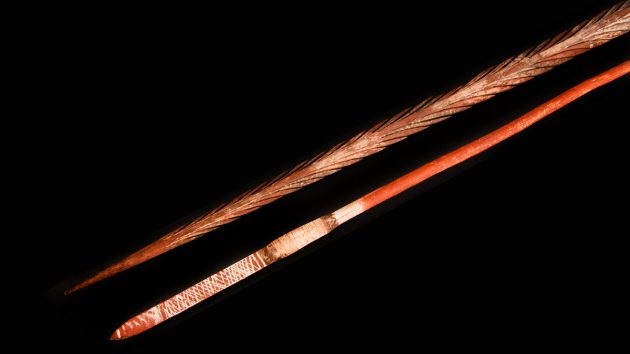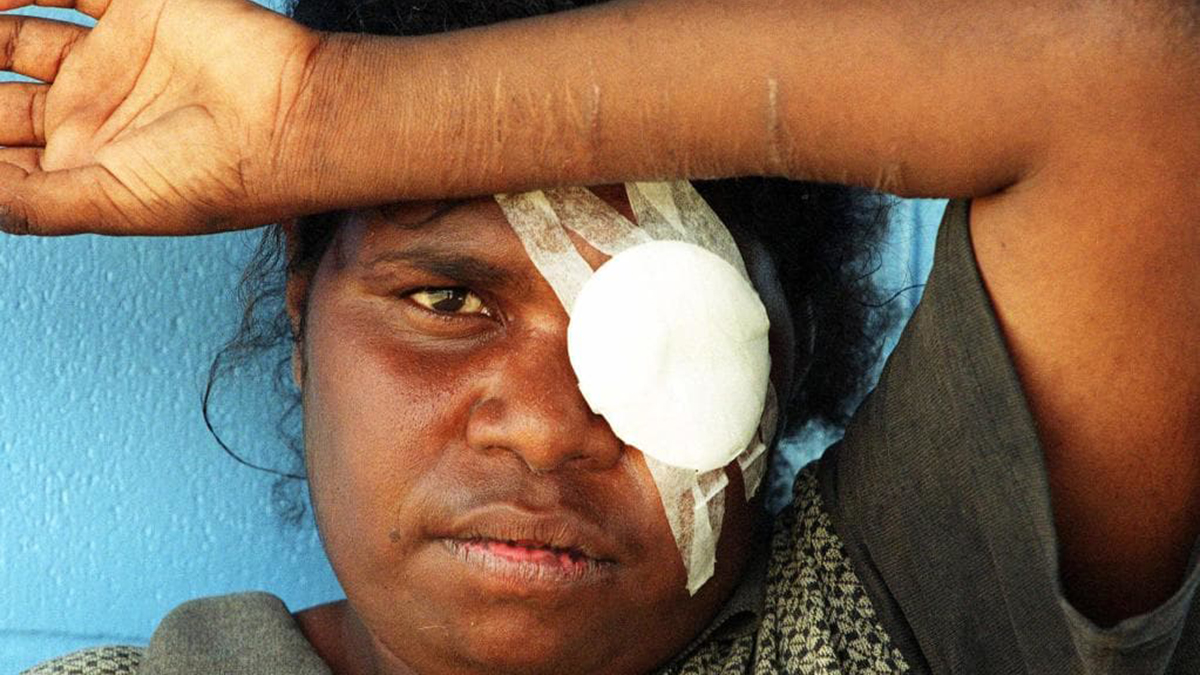Here in Tasmania, professional Aboriginal agitators are going all-in on their latest campaign: to “hand back” “stolen” Aboriginal petroglyphs in Tasmanian museums. Never mind that, as one local Aboriginal man said, the museums actually saved the artworks from almost certain destruction. His preference, he said, was for the artefacts to eventually be housed in museum settings in their original locations.
Activists, on the other hand, just want to grab them and bury them, far from “white” view. This is all a pattern in recent years of: “reclaiming” material collected in museums over the last two hundred years and chucking them back in the dirt. While some of the items were clearly taken under reprehensible circumstances – such as Truganini’s skeleton, against her specific wishes; or the macabre theft of William Lannie’s head, which caused outrage even at the time – one must wonder at the motives for grabbing and burying others.
Certainly, many of the relics have cast a scientific light on otherwise unrecorded history. A light some activists might prefer kept shrouded.
In his address to the National Press Club in 2003, Mick Dodson claimed that “violence is not and never was part of Aboriginal tradition … We have no cultural traditions based on humiliation, degradation, and violation. Let me make this point abundantly clear. Most of the violence, if not all, that Aboriginal communities are experiencing today [is] not part of Aboriginal tradition or culture.”
This is, not to put too fine a point on it, utter and complete hooey.
Pre-contact Aboriginal society was very violent, and that violence and the cultural norms that sustained it continue to generate the extreme levels of violence in today’s remote communities.
There is little point in criticising traditional Aboriginal Australia, unless traditions pose dangers for today’s Aborigines, and unless we incorporate this reality into policy responses.
This is clear to anyone who reads, say, the memoirs of William Buckley, the English convict who spent decades living with and as one of the Aboriginal people in what is now the Geelong area. Buckley’s account of pre-contact Aboriginal culture is one of extraordinary violence. Similarly, accounts from officers of the First Fleet record their shock at the violence often meted out by Aboriginal men to women. Apologists will no doubt write this off as “racism”, but bear in mind that these officers were men living in what was by today’s standards a violent enough society. For officers used to dealing out brutal punishments for most offences to be shocked by the sight of Aboriginal women being clubbed over the head for trivial slights, says a great deal indeed.
Then there is the objective evidence gleaned from forensic archaeology.
The particularly high level of violence against women in pre-contact Aboriginal Australia can no longer be denied. First-contact explorers and colonists noted with distress the terrible scars and bruises that marked the women due to the frequent brutality of their menfolk.
Stephen Webb‘s palaeopathology studies of cranial and post-cranial remains verify that before European arrival, violence against Aboriginal women was prevalent across the mainland continent, with women suffering significantly more cranial injuries than men.
The great shame is that this is not just a matter of dry history. For too many Aboriginal women and children, it is their living reality.
The level of Aboriginal violence particularly against women remains shocking. In 2004-05 across four states where records were kept “indigenous females were 44.1 times more likely to be hospitalised for assault than non-Indigenous females”[…]
However, insistent blaming of white colonisation as a primary generator of high Aboriginal violence suppresses the uncomfortable fact that within Aboriginal culture, violence continues to have strong, traditional legitimacy.

As some Aboriginal women are brave enough to say openly (thus inviting vituperative attacks from the Aboriginal establishment), Aboriginal men can no long blame “whitey” for their own crimes. Nor should they be allowed to use “culture” as a smokescreen.
White, urban activists just love “Aboriginal culture”. Having abandoned almost all of their own Western cultural and religious framework, these empty vessels are filling the void with “Welcome to Country” ceremonies and “acknowledgement of traditional owners”. The same people who sneer at “superstition” when it wears a cassock, prostrate themselves when it wears a possum-skin cloak. Wokeists who moan and tear their hair about the vanishingly rare and ever-decreasing violence against women in Western culture, rush to defend the most appalling brutality against women and children in the name of “traditional culture”.
The key difference between the West and traditional Aboriginal culture is that only very recently, Western culture developed effective philosophies and associated political and legal systems that could effectively reduce violence.
In contemporary liberal democracies, violence is forbidden. For private citizens there is no legitimised violence apart from self-defence. Within traditional Aboriginal culture, there was considerable legitimate scope for people to use violence.
Hence, reducing Aboriginal violence to around mainstream levels will entail further shifts away from traditional beliefs, norms, power structures and behaviours.
Especially “traditional culture”. Because the evidence is clear that Aboriginal violence is not a “legacy of colonialism” but of traditional culture. In fact, the more integrated Aboriginal men are into “white” society, it seems the less likely they are to be violent.
Joan Kimm and David McKnight, within their respective fields of legal history and anthropology, recount how the tolerance of violence or the propensity to behave violently can increase markedly in the same people when they move out of the mainstream and into traditional community. In his book From Hunting to Drinking, McKnight relates how Mornington Island youths were able to treat their white girlfriends well in the mainstream context but became violent towards them in the traditional context.
This suggests that when and where to be violent is a matter of choice[…]People generally want to conform to their culture. They tend to be as violent and as tolerant of violence as their culture expects and allows.
Former prime minister Tony Abbott – who selflessly dedicated significant time to boots-on-the-ground work in Aboriginal communities – was vilified by the left-elite when he said that Aborigines choosing to live in tiny, remote communities was a “lifestyle choice”. Abbott was completely right, of course: nothing stops people from moving to better opportunities but their choice to remain.
A choice which does not seem to be conducive to the well-being of many Aboriginal women and children.
Adjustment to the mainstream is not about taking anything from Aborigines. It is about implementing policies and programs that reverse Aboriginal exclusion from mainstream culture, because this is the only effective broad-scale strategy for the acquisition of strong norms against violence. It is critical that governments encourage integration, otherwise Aborigines are condemned to dangerous traditional norms of violence. Those norms not only cause misery and suffering, they also limit the life chances that many Aborigines could enjoy within contemporary Australia.
News.com.au
“Progressives” and the Aboriginal establishment will almost certainly react with fury to any suggestion that some Aboriginal people must abandon many aspects of traditional culture. “How dare you!” they will shriek. Yet, that’s exactly what white Westerners have done. As Steven Pinker has shown, not so long ago Western culture would have shocked modern sensitivities with its violence. Yet we gradually abandoned all that, to adopt a culture that respects the rights of women and children – not to mention men – to live lives as free from violence as possible.
To paraphrase C S Lewis, to argue that a people must be forever bound to a culture of brutality because it is somehow their “nature” is to argue that they “be put on a level with those who have not yet reached the age of reason or those who never will; … classed with infants, imbeciles, and domestic animals”. Asking a people to abandon such a culture because they can and ought to do better is to ask that they “be treated as a human person made in God’s image”.
If Westerners could do it, why can’t Aboriginal people? Arguing otherwise is nothing more than the racism of lowered expectations.
Please share this article so that others can discover The BFD

